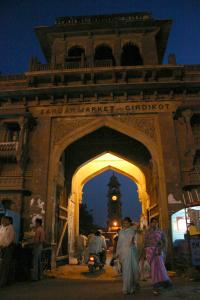|
Within minutes of arriving in India, the reality of life in the subcontinent hits you in the face like a frying pan. A population of over a billion people crowds around you, desperately trying to get a few coins from the pocket of the newly arrived Westerner. Traffic of a spellbinding variety fills every square inch of the streets, and even sidewalks -- brightly decorated freight trucks, 1950s-style passenger cars, bicycles, motor scooters, rickshaws, oxcarts, camels, and pedestrians. They whiz by you with the deafening roar of a hundred two-stroke engines, miraculously managing to avoid the countless dairy cows that randomly wander through the chaotic streets. Quick learning is needed not only to negotiate this traffic, but to keep clear the curbside waste left behind by millions of cows, pigs, dogs, and people.
 |
|
Camel
Trekking in Rajasthan
|
After a full day of such chaos, it is an immense pleasure to see the sun lower to the horizon. The soft light of sunset signals a time when everything starts to slow down. The shadows grow longer until they fully cover the streets, hiding the country's frayed edges, and letting the full beauty of three thousand years of civilization show through. In the western desert province of Rajasthan, the sun sinks down below the camels used to ferry traders and tourists alike. At dusk, floodlights create a magical glow on the enormous fortresses that guard the cities of Jaisalmer and Jodhpur, as well as the palaces of Udaipur. Throughout the country, night markets come to life.
Independent travel in India is not for the feint of heart. Long, tiring days assault the senses with sights, sounds, smells that are at times both awesome and awful. But once you learn to live with the challenges of this country, there are enough destinations and experiences to keep a hard-core traveler busy for months.
 |
|
Jodhpur's
Central Market
|
Another popular beach, across the peninsula at Mamallapuram, stretches both ways from the ancient Shore Temple along the Bay of Bengal. Sadly, the beaches are polluted near the town that hosts the temple and other spectacular rock carvings. A few miles north, however, a series of resorts offer clean beaches in a pleasant setting.
With so many spectacular sights to see in India, these beaches are best used as points to recharge your batteries before seeing nearby sights such as the spectacular temples of Madurai, the beautiful backwaters of Karala, and the historic settlement at Cochin. Getting from one place to another is best done by rail or plane -- preferably using the better than Western-quality service of Jet Airways. Their 2-week air pass lets you fly anyplace in the country for $500, including easy booking by agents in the United States. Compare this efficiency with the chaos of reserving train tickets in India. Popular sleeper trains (like the one to Jaisalmer) sell out weeks in advance, but advance sales can only be made over the Internet to a customer address within India. Lines to buy tickets at train stations can be long, and require following complex, seemingly random procedures.
 |
|
A
Peaceful Taj Mahal
|
But the hassles of train stations are nothing compared with what the visitor experiences upon arrival in Jaipur or Agra, two of the cities most frequented by new arrivals. Con men crowd the train and bus stations, and buzz around tourists like flies. Getting rid of them politely can be tricky -- every one of them insists he is your friend.
But it is well worth going to both these places. Jaipur is the gateway to Rajasthan, with spectacular forts, walled cities, palaces, and camel trekking. And Agra is home to the Taj Mahal, a place so hyped that it has become a tourist cliche, but with such beauty that it still manages to knock the wind out of a first-time visitor. Here, as in the rest of India, it is at sunset that the experience becomes much more manageable. At dusk, the teeming masses that cover the gardens in front of the Taj begin to retreat, giving the visitor enough breathing room to look forward to yet another day in India.
David G. Young and Kerry Dooley vacationed in India for three weeks in November 2003.
See the complete set of photos from this trip.

